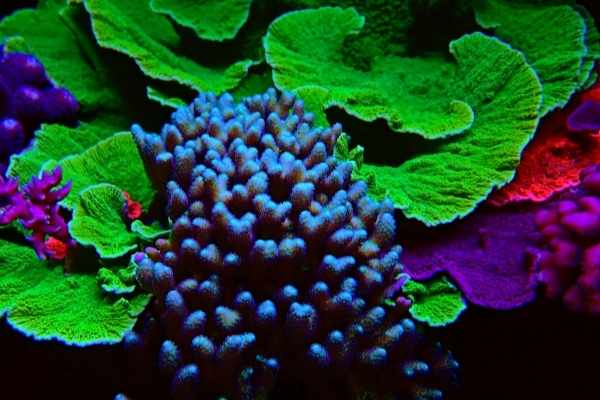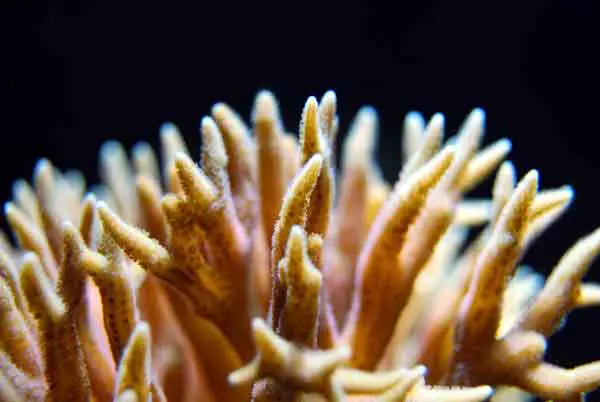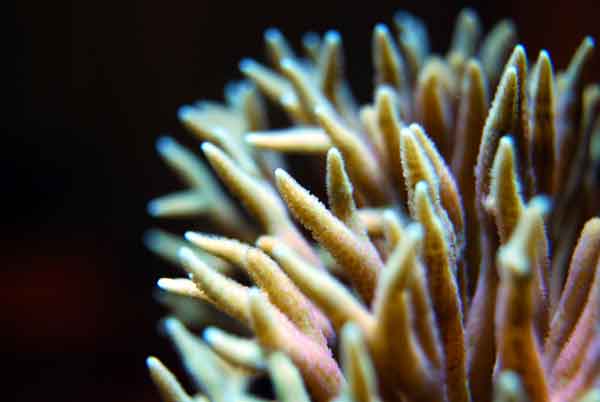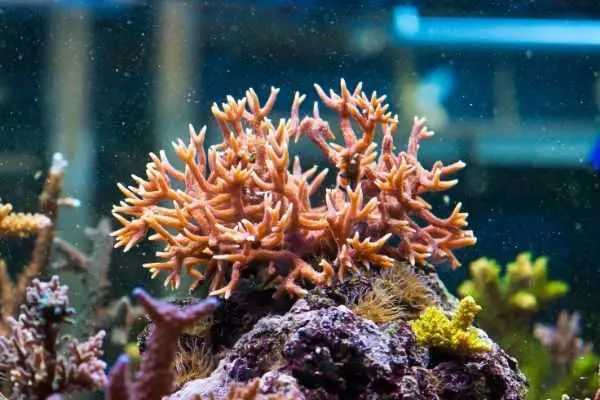The bird’s nest coral is a small polyp stony coral (shortened to SPS by many aquarium owners) with thin yellow, green, purple, or pink branches that grow into a densely intertwined mass resembling a bird’s nest. (No one said biologists were creative with their naming schemes)
As far as SPS corals go, the bird’s nest coral is one of the easiest. But that doesn’t mean this species is suitable for the uninitiated aquarist to plunk into a reef tank. Caring for any coral – especially an SPS coral – is a moderately difficult endeavor best left to those who have achieved at least SOME level of reef aquarium success.
But if you can meet its water quality and lighting requirements? A small frag or broken branch may be all you’ll need to grow a nice-sized colony in your reef tank.
Table of Contents: Bird’s Nest Coral Care
Looking for something specific regarding bird’s nest coral management? You can use this handy TOC to jump to a specific topic. But the entire article’s available for anyone who wants to gain a thorough understanding of this gorgeous SPS species.
- Quick Facts
- Natural Habitat of Bird’s Nest Corals
- Placement of Bird’s Nest Coral in a Reef Tank
- Water Parameters
- Feeding Bird’s Nest Corals
- Bird’s Nest Coral Compatibility
- Reproduction and Fragging
- For More Information
- References
Quick Facts
- Scientific Name: Seriatopora hystrix
- Common Names: Bird’s nest coral, Needle coral, Finger coral, Brush coral
- Aggression Level: Low, peaceful
- Care Level: Moderate overall; Within the SPS category – Moderately-easy
- Flow: Moderate to high
- Lighting: Strong
- Placement: Close to lights
- Feeding: Recommended for maximum health and growth. Use tiny particle (planktonic or planktonic-sized) foods

Natural Habitat of Bird’s Nest Corals
The scientific name for the bird’s nest coral is Seriatopora hystrix. You can also find it called the purple bird’s nest coral, finger coral, needle coral, and brush coral, depending on what part of the world you herald from. If you’re a big fan of taxonomy (and who isn’t?) or have taxonomist friends, you’ll be delighted to know that this coral belongs to the Pocilliporidae family, which also contains Pocillopora and Stylophora corals, which frequently crop up in the hobby, as well. They all share a few key attributes (but you already knew that since you’re a biology geek).
The bird’s nest coral and other members of the Seriatopora genus have an extensive natural habitat. They show up along the expansive east coast of Africa, the Mauritius Islands, Madagascar, the Red Sea, the Cocos Island Ridge, and all the way out to Australia’s west coast in the Houtman Abrolhos Islands, up the northern Australian coast, and around to the Australian east coast and the Lord Howe Islands. (Or, if you want the short story, the Indo-Pacific) They often hug shallow reefs and upper reef slopes at depths between 20 to 115 feet (6-25m).
The coral is arborescent, meaning they develop branches like trees. The growth of the branches depends on the strength and direction of the water flow. So the stronger the current, the thicker the branches. It grows into a twisted bunch of branches that fuse at certain points. The branches can be blunt or needle-like, and the coral grows up to 1-1.5 feet (0.3-0.5m) in size. Corals collected at greater depths tend to have thinner stalks. Bird’s nest corals can have various colors, including brown, orange, pink, green, yellow, purple, or even combinations of those colors.
Bird’s nest corals have a communalistic relationship with different crabs, such as the female of the gall-forming Hapalocarcinus marsupialis crab. This crab plays a major role in the coral’s growth pattern. The female crab shapes the growth of the coral’s thin branches to create a cage where it lives permanently. There’s just enough space to allow the smaller male crab to enter and mate with the female. The female crab lives its entire life in the branches of the bird’s nest coral.
It’s an awesome detail, and divers and snorkelers enjoy coming across these pairs. However, it’s not expedient to introduce these crabs to a captive environment. So you’ll need to settle for tucking the information tidbit away to share with visitors to your display tank when they drop by and admire your reef tank.

Placement of Bird’s Nest Corals in a Reef Tank
You only want to keep the bird’s nest coral in a mature reef tank that is AT LEAST six months old for best results. And, if you can muster the patience, 1.5 years old is best. You don’t want to attempt to introduce them to a new saltwater aquarium. They’re too fragile for that.
Lighting
Bright light produces the fastest growth, but the coral may not do well with intense light if it was living at a lower depth when it was collected. The genetic makeup influences its lighting tolerance. For instance, the yellow bird’s nest tolerates moderate lighting conditions. But the pink variety? It suffers if it doesn’t receive intense lighting. Getting the lighting right is crucial if you want this coral to thrive. Otherwise, you’ll end up with a sick and bleached coral – even with all the care and nurturing in the world.
The best practice is to gradually acclimate your new specimen to the light in your tank. Decreasing the initial light intensity to about 50% and increase it moderately over time to the desired intensity. You can also work by moving the coral to various depths within the tank. Start at the bottom and watch to see how the coral looks. Then start to move it up over a few days, waiting to see if the colors bleach.
Any time you see a loss of color, that’s bleaching, and it means your light intensity is too high. Either turn things down or shift your bird’s nest a step back toward the bottom. It’s trial and error, and it takes time, but it’s the best way to manage lighting for this species.
Water Flow
Wouldn’t it be nice if bird’s nest corals made things simple in regards to their placement? No such luck – even with their flow choices. You need to look at a few different aspects to decide what kind of current to stick with. And the first (and easiest) is the thickness of their branches. A broad, thick coral branch can withstand a higher water flow without too much trouble. The corals DO exist in turbid regions on reefs throughout their natural habitat. And the stony skeletons can handle the extra current.
But when those branches are thin, you need to dial things back into the moderate range. If the flow goes too high, your bird’s nest won’t open its polyps. That means it will slowly starve to death. If you’re not sure about the branch size, start at the moderate level and see how your bird’s nest coral grows. You can always increase the water flow over time.
Because if you start seeing hair algae show up? That’s a signal your current’s too slow.

“No Pushing!”
While the bird’s nest coral can tolerate other corals, it’s important that it does NOT touch other corals. This is really a best practice for all coral species (although some Euphyllia corals can touch without problems). But if your corals are even close to touching one another? You’re probably doing it wrong. (No offense)
One thing that requires significant self-restraint in this hobby is placing your corals far enough apart. You need room to allow them to grow into a reasonable colony size – without encroaching too much on neighboring corals. (Remember, “No touchee!”) Try to think a few years in advance when placing your corals.
Water Parameters
Bird’s nest corals need stable reef-quality water parameters to grow successfully. That is best achieved by mixing RO/DI water with a high-quality reef aquarium salt mix. You want your aquarium to maintain the following levels:
- Alk: 8-12 dkh
- pH: 8.2-8.4
- Temperature: ~78-82F (25.5-27.7C)
- Salinity: 1.025 specific gravity
- Calcium: 400ppm
- Ammonia, Nitrites, Nitrates, Phosphates, Silicates: 0ppm
And, as you probably guessed (needing a mature tank), you want to stay on top of your cleaning regime. Dirty tanks lead to diseases.
Feeding Bird’s Nest coral
Bird’s nest coral can survive on its own without feeding. The zooxanthellae algae that live inside it will provide nourishment via photosynthesis. And that’s where they receive the majority of their nutrients. But corals are animals, and all animals need to eat.
Extended polyps from the stony branches capture and remove appropriately sized food particles (like plankton). Your bird’s nest will do this to pick up dropped food from the fish in your tank. But you can also target feed your coral to make sure they’re receiving the proper nutrition.
For best results, start by GENTLY shooting a small amount of food in the direction of your coral. A lot of times, this will initiate a feeding response. You’ll see the coral extend its polyps in search of a meal. Turn off the water flow pumps (many pumps, like gyre models, have a feeding button that pauses the water flow for 10 minutes to allow these kinds of feedings) and target feed them using a turkey baster, syringe, or Julian’s thing.

Bird’s Nest Coral Compatibility
The bird’s nest coral is not an overly aggressive aquarium coral – at least to other Seriatopora corals. Even with other species, it doesn’t have a lethal arsenal at its disposal to wage war. That means you don’t have to worry much about it leaking toxins into the water that can kill its neighbors or stinging sweeper tentacles, like you have to worry with some of the LPS corals, like Acans, Favia, Blastomussa , and even Hammer, Torch and Frogspawn corals.
It IS fairly fast-growing (by SPS coral standards), so the most important thing is to give plenty of room for it and its neighbors to grow. Otherwise, you can see those branches shoving neighbors out of the way. (You know, that passive-aggressive issue)
Reproduction and Fragging
The bird’s nest coral can reproduce sexually or asexually, though sexual reproduction for any coral is rare in captivity. But corals reproduce asexually by fragmentation and breakage, which is something the bird’s nest excels at. The thin branches break easily when bumped or moved around the tank. (This isn’t permission, by the way)
You can propagate your bird’s nest coral by fragmentation. Look for a healthy section of the coral and cut off a branch around 2 inches (5cm) in length. You’re going to see “slime” along the cut surface. This is normal, but you don’t want the slime to touch any of the other corals in your tank. Glue the frag to a rock or reef plug, making sure it’s glued on its side. This promotes faster growth and provides plenty of water flow.
Want to learn more about fragging and coral reproduction? It happens that I have a handy guide all about the subject!

For More Information
Now that you’ve gotten your interest piqued for bird’s nest corals, why not dive into some more information about them?
Start here with a handy YouTube video about these gorgeous SPS corals:
Or maybe you’re interested in another SPS coral you could add to your reef tank? Why not look at the montipora coral as your next inspiration?
Maybe you want to go in a different direction completely and start investigating large polyp stony (LPS) corals. No problem – got you covered there, too:
- Acan coral
- Candy cane coral
- Duncan coral
- Elegance coral
- Flower pot coral
- Scoly coral
- Sun coral
- Toadstool coral
- Torch coral
- Trumpet coral
Conclusions
The bird’s nest coral is sometimes considered a gateway SPS coral. It’s the coral most commonly turned to first when an aquarium owner wants to try growing SPS in their tank. And even though it’s one of the least demanding SPS corals, it requires an intermediate level of care to be successful.
It IS simple to grow from a small broken branch or frag. And this coral will tolerate minor fluctuations in water parameters. It’s also a hardy, fast-growing species. That makes it appealing to people who can support its tricky lighting and flow needs. But if you take the time to carefully transport and gently acclimate your bird’s nest, you’ll find it “blossoming” within your reef tank. Just make sure you provide sufficient lighting, maintain solid water quality and feed this amazing creature. And you’ll be amazed to see how quickly the thin branches grow and fill in space in your tank.
References
- Borneman, Eric H. Aquarium Corals. Microcosm Ltd; 1st Printing Edition (March 1, 2001)
- Ulrich III, Albert B. How to Frag Corals: Step-by-Step Guide to Coral Propagation and Filling Your Frag Tank With Thriving Polyps.
What’s Your Experience?
Have you tried to keep Seriatopora hystrix? If so, please share your experiences in a comment below. What advice would you give?


Leave a Reply